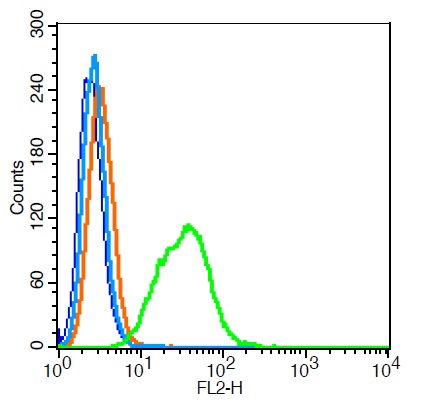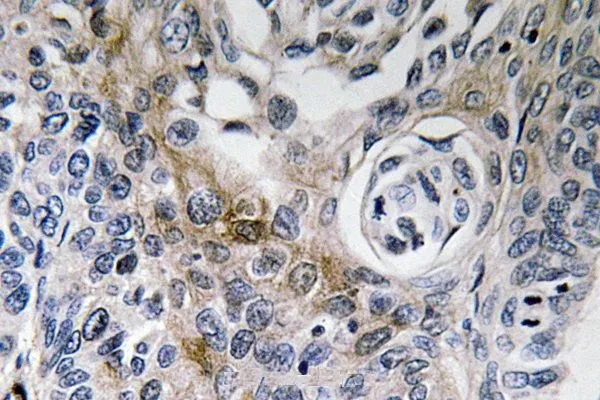![ICC/IF analysis of HeLa cells using GTX28219 CD63 antibody [MEM-259]. Green : Primary antibody Red : Actin Blue : DAPI ICC/IF analysis of HeLa cells using GTX28219 CD63 antibody [MEM-259]. Green : Primary antibody Red : Actin Blue : DAPI](https://www.genetex.com/upload/website/prouct_img/normal/GTX28219/GTX28219_20191025_AP_002_213_w_23060722_894.webp)
ICC/IF analysis of HeLa cells using GTX28219 CD63 antibody [MEM-259]. Green : Primary antibody Red : Actin Blue : DAPI
CD63 antibody [MEM-259]
GTX28219
ApplicationsFlow Cytometry, ImmunoFluorescence, ImmunoPrecipitation, Western Blot, ELISA, ImmunoCytoChemistry, ImmunoHistoChemistry, ImmunoHistoChemistry Paraffin
Product group Antibodies
TargetCD63
Overview
- SupplierGeneTex
- Product NameCD63 antibody [MEM-259]
- Delivery Days Customer9
- Application Supplier NoteWB: 1:1000. ICC/IF: 10 microg/ml. IHC-P: 10 microg/ml. FACS: 2 microg/ml. *Optimal dilutions/concentrations should be determined by the researcher.Not tested in other applications.
- ApplicationsFlow Cytometry, ImmunoFluorescence, ImmunoPrecipitation, Western Blot, ELISA, ImmunoCytoChemistry, ImmunoHistoChemistry, ImmunoHistoChemistry Paraffin
- CertificationResearch Use Only
- ClonalityMonoclonal
- Clone IDMEM-259
- Concentration1 mg/ml
- ConjugateUnconjugated
- Gene ID967
- Target nameCD63
- Target descriptionCD63 molecule
- Target synonymsAD1, HOP-26, ME491, MLA1, OMA81H, Pltgp40, TSPAN30, CD63 antigen, AD1 antigen, CD63 antigen (melanoma 1 antigen), granulophysin, limp1, melanoma-associated antigen ME491, melanoma-associated antigen MLA1, ocular melanoma-associated antigen, tetraspanin-30, tspan-30
- HostMouse
- IsotypeIgG1
- Protein IDP08962
- Protein NameCD63 antigen
- Scientific DescriptionThe protein encoded by this gene is a member of the transmembrane 4 superfamily, also known as the tetraspanin family. Most of these members are cell-surface proteins that are characterized by the presence of four hydrophobic domains. The proteins mediate signal transduction events that play a role in the regulation of cell development, activation, growth and motility. The encoded protein is a cell surface glycoprotein that is known to complex with integrins. It may function as a blood platelet activation marker. Deficiency of this protein is associated with Hermansky-Pudlak syndrome. Also this gene has been associated with tumor progression. Alternative splicing results in multiple transcript variants encoding different protein isoforms. [provided by RefSeq, Apr 2012]
- Storage Instruction2°C to 8°C
- UNSPSC12352203
References
- Endosomal Arl4A attenuates EGFR degradation by binding to the ESCRT-II component VPS36.Read more
- An intercellular transfer of telomeres rescues T cells from senescence and promotes long-term immunological memory.Read more
- Plasma extracellular vesicle derived protein profile predicting and monitoring immunotherapeutic outcomes of gastric cancer. Zhang C et al., 2022 Apr, J Extracell VesiclesRead more
- Cell-Matrix Interactions Regulate Functional Extracellular Vesicle Secretion from Mesenchymal Stromal Cells.Read more
- LINC00511 drives invasive behavior in hepatocellular carcinoma by regulating exosome secretion and invadopodia formation. Peng X et al., 2021 Jun 4, J Exp Clin Cancer ResRead more
- IKKbeta activation promotes amphisome formation and extracellular vesicle secretion in tumor cells. Peng X et al., 2021 Jan, Biochim Biophys Acta Mol Cell ResRead more
- Long non-coding RNA HOTAIR promotes exosome secretion by regulating RAB35 and SNAP23 in hepatocellular carcinoma. Yang L et al., 2019 Apr 3, Mol CancerRead more
- Annexin A1 regulates EGFR activity and alters EGFR-containing tumour-derived exosomes in head and neck cancers. Raulf N et al., 2018 Oct, Eur J CancerRead more
- beta2-microglobulin amyloid fibrils are nanoparticles that disrupt lysosomal membrane protein trafficking and inhibit protein degradation by lysosomes. Jakhria T et al., 2014 Dec 26, J Biol ChemRead more
- Enrichment and analysis of secretory lysosomes from lymphocyte populations. Schmidt H et al., 2009 Jul 29, BMC ImmunolRead more

![ICC/IF analysis of human primary fibroblasts using GTX28219 CD63 antibody [MEM-259]. Green : Primary antibody Red : Actin Blue : DAPI ICC/IF analysis of human primary fibroblasts using GTX28219 CD63 antibody [MEM-259]. Green : Primary antibody Red : Actin Blue : DAPI](https://www.genetex.com/upload/website/prouct_img/normal/GTX28219/GTX28219_20191025_AP_002_214_w_23060722_914.webp)
![ICC/IF analysis of human skin fibroblasts using GTX28219 CD63 antibody [MEM-259]. Green : Primary antibody Red : Transferrin Blue : DAPI ICC/IF analysis of human skin fibroblasts using GTX28219 CD63 antibody [MEM-259]. Green : Primary antibody Red : Transferrin Blue : DAPI](https://www.genetex.com/upload/website/prouct_img/normal/GTX28219/GTX28219_20191025_AP_002_215_w_23060722_830.webp)
![FACS analysis of IgE-activated peripheral blood using GTX28219 CD63 antibody [MEM-259]. FACS analysis of IgE-activated peripheral blood using GTX28219 CD63 antibody [MEM-259].](https://www.genetex.com/upload/website/prouct_img/normal/GTX28219/GTX28219_20191025_AP_006_212_w_23060722_463.webp)




![FACS analysis of peripheral blood lymphocytes from a patient with allergy to bee venom after stimulation with bee venom using GTX18235 CD63 antibody [MEM-259] (FITC).](https://www.genetex.com/upload/website/prouct_img/normal/GTX18235/GTX18235_20191025_AP_006_134_w_23060620_554.webp)
![FACS analysis of IgE-activated peripheral blood using GTX18236 CD63 antibody [MEM-259] (PE).](https://www.genetex.com/upload/website/prouct_img/normal/GTX18236/GTX18236_20191025_AP_006_135_w_23060620_482.webp)
![IHC-P analysis of human melanoma tissue using GTX21318 CD63 antibody [NK1/C3NKI/C3 (MX-49.129.5)].](https://www.genetex.com/upload/website/prouct_img/normal/GTX21318/GTX21318_20191203_IHC-P_82_w_23060620_402.webp)